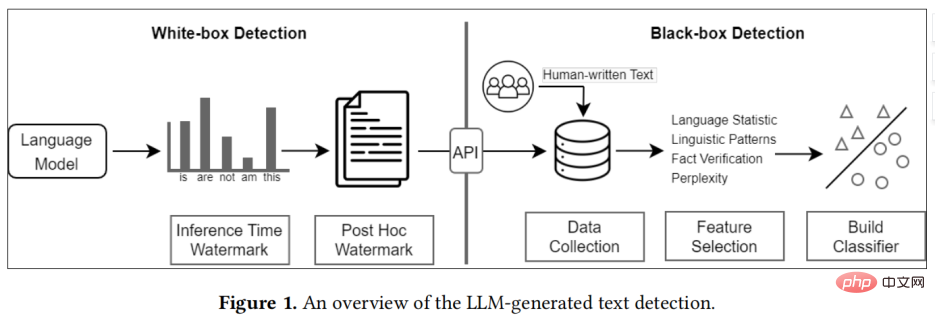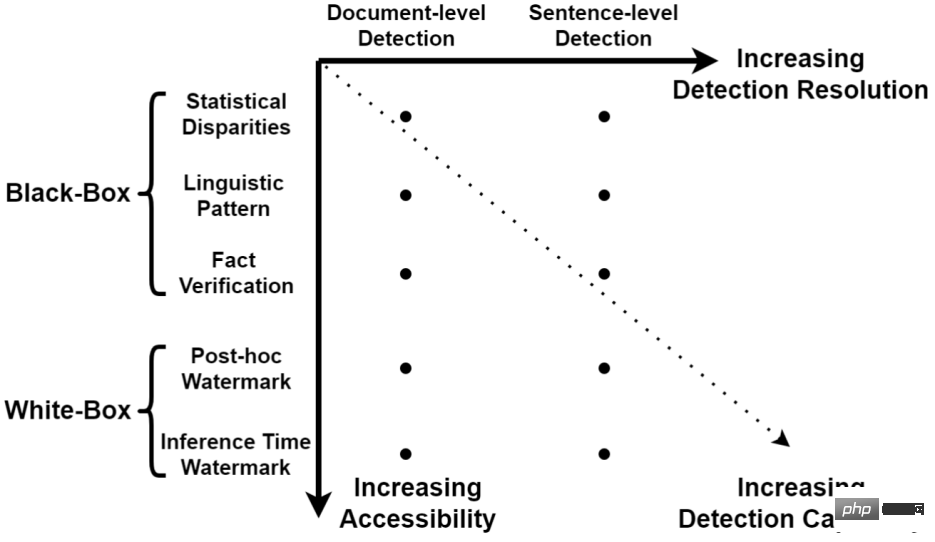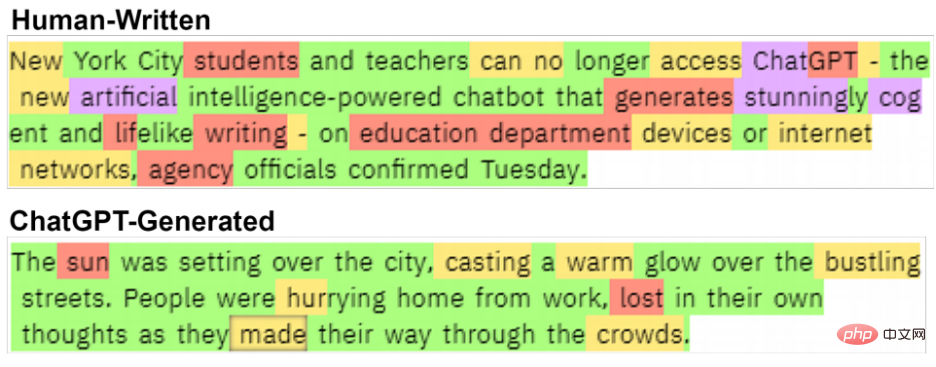 Technology peripherals
Technology peripherals
 AI
AI
 Pretending to be a human author, ChatGPT and other abuses cause concern, an article summarizes AI-generated text detection methods
Pretending to be a human author, ChatGPT and other abuses cause concern, an article summarizes AI-generated text detection methods
Pretending to be a human author, ChatGPT and other abuses cause concern, an article summarizes AI-generated text detection methods
Recent advances in natural language generation (NLG) technology have significantly improved the variety, control, and quality of text generated by large language models. One notable example is OpenAI’s ChatGPT, which has demonstrated superior performance in tasks such as answering questions, writing emails, papers, and code. However, this newfound ability to efficiently generate text also raises concerns about detecting and preventing the misuse of large language models in tasks such as phishing, disinformation, and academic dishonesty. For example, due to concerns about students using ChatGPT to write homework, New York public schools banned the use of ChatGPT, and the media also issued warnings about fake news generated by large language models. These concerns about the misuse of large language models have seriously hindered the application of natural language generation in important fields such as media and education.
There has been increasing discussion recently about whether and how to correctly detect text generated by large language models. This article provides a comprehensive technical introduction to existing detection methods.

- Paper address: https://github.com/datamllab/The-Science- of-LLM-generated-Text-Detection
- Related research address: https://github.com/datamllab/awsome-LLM-generated-text-detection /tree/main
Existing methods can be roughly divided into two categories: Black box detection and white box detection.

Overview of Large Language Model Generation for Text Detection
- Black box detection methods usually only have API level access to large language models. Therefore, this type of approach relies on collecting text samples from humans and machines to train classification models;
- #White-box detection, this type of approach has all access to large language models and can Track and detect generated text by controlling the generation behavior of the model or adding watermarks to the generated text.
In practice, black-box detectors are usually built by third parties, such as GPTZero, while white-box detectors are usually built by large language model developers.

Large-scale language modelGenerated text detection taxonomy
BlackBoxDetection
Black box detection generally has three steps, namely data collection, feature selection and model establishment.
For the collection of human text, one method is to recruit professionals for data collection, but this method is time-consuming and labor-intensive and is not suitable for the collection of large data sets. A more efficient method is to use Existing human text data, such as collecting entries edited by various experts from Wikipedia, or collecting data from media, such as Reddit.
Feature selection is generally divided into statistical features, linguistic features and factual features. The statistical features are generally used to check whether the text generated by a large language model is different from human text in some commonly used text statistical indicators. Commonly used ones include TFIDF, Zipf's Law, etc. Linguistic features generally look for some linguistic features, such as parts of speech, dependency analysis, sentiment analysis, etc. Finally, large language models often generate counterfactual statements, so fact verification can also provide some information that distinguishes text generated by large language models.
Existing classification models are generally divided into traditional machine learning models, such as SVM. The latest research tends to use language models as the backbone, such as BERT and RoBERTa, and has achieved higher detection performance.

There are clear differences between the two texts. human-written text from Chalkbeat New York.
White box detection
White box detection generally defaults to detection provided by large language model developers. Different from black-box detection, white-box detection has full access to the model, so it can implant watermarks by changing the output of the model to achieve the purpose of detection.
The current detection methods can be divided into post-hoc watermark and inference time watermark:
- The post-hoc watermark is to add some hidden information to the text for subsequent detection after the large language model has generated the text;
- Inference time watermark It is to change the token sampling mechanism of the large language model to add watermarks. In the process of generating each token by the large language model, it will select the next generated word based on the probability of all tokens and the preset sampling strategy. This choice You can add watermark in the process.

Inference time watermark
The author is worried
(1)For the black box model, data collection is a very critical step, but this process is very easy to introduce biases. For example, existing data sets mainly focus on several tasks such as question and answer and story generation, which introduces subject bias. In addition, text generated by large models often has a fixed style or format. These biases are often used by black-box classifiers as the main features for classification and reduce the robustness of detection.
As the capabilities of large-scale language models improve, the gap between the text generated by large-scale language models and humans will become smaller and smaller, resulting in the detection accuracy of black-box models getting lower and lower. Therefore, white-box detection is a more promising detection method in the future.
(2)Existing detection methods default to large language models owned by the company, so all Users obtain the company's large-scale language model services through APIs. This many-to-one relationship is very useful for the deployment of detection systems. But if the company open sourced a large language model, this would cause almost all existing detection methods to become ineffective.
For black-box detection, because users can fine-tune their models and change the style or format of model output, black-box detection cannot find common detection features.
White box detection may be a solution. Companies can add a watermark to the model before open source. However, users can also fine-tune the model and change the sampling mechanism of the model token to remove the watermark. There is currently no watermarking technology that can protect users from these potential threats.
The above is the detailed content of Pretending to be a human author, ChatGPT and other abuses cause concern, an article summarizes AI-generated text detection methods. For more information, please follow other related articles on the PHP Chinese website!

Hot AI Tools

Undresser.AI Undress
AI-powered app for creating realistic nude photos

AI Clothes Remover
Online AI tool for removing clothes from photos.

Undress AI Tool
Undress images for free

Clothoff.io
AI clothes remover

AI Hentai Generator
Generate AI Hentai for free.

Hot Article

Hot Tools

Notepad++7.3.1
Easy-to-use and free code editor

SublimeText3 Chinese version
Chinese version, very easy to use

Zend Studio 13.0.1
Powerful PHP integrated development environment

Dreamweaver CS6
Visual web development tools

SublimeText3 Mac version
God-level code editing software (SublimeText3)

Hot Topics
 1385
1385
 52
52
 The world's most powerful open source MoE model is here, with Chinese capabilities comparable to GPT-4, and the price is only nearly one percent of GPT-4-Turbo
May 07, 2024 pm 04:13 PM
The world's most powerful open source MoE model is here, with Chinese capabilities comparable to GPT-4, and the price is only nearly one percent of GPT-4-Turbo
May 07, 2024 pm 04:13 PM
Imagine an artificial intelligence model that not only has the ability to surpass traditional computing, but also achieves more efficient performance at a lower cost. This is not science fiction, DeepSeek-V2[1], the world’s most powerful open source MoE model is here. DeepSeek-V2 is a powerful mixture of experts (MoE) language model with the characteristics of economical training and efficient inference. It consists of 236B parameters, 21B of which are used to activate each marker. Compared with DeepSeek67B, DeepSeek-V2 has stronger performance, while saving 42.5% of training costs, reducing KV cache by 93.3%, and increasing the maximum generation throughput to 5.76 times. DeepSeek is a company exploring general artificial intelligence
 AI subverts mathematical research! Fields Medal winner and Chinese-American mathematician led 11 top-ranked papers | Liked by Terence Tao
Apr 09, 2024 am 11:52 AM
AI subverts mathematical research! Fields Medal winner and Chinese-American mathematician led 11 top-ranked papers | Liked by Terence Tao
Apr 09, 2024 am 11:52 AM
AI is indeed changing mathematics. Recently, Tao Zhexuan, who has been paying close attention to this issue, forwarded the latest issue of "Bulletin of the American Mathematical Society" (Bulletin of the American Mathematical Society). Focusing on the topic "Will machines change mathematics?", many mathematicians expressed their opinions. The whole process was full of sparks, hardcore and exciting. The author has a strong lineup, including Fields Medal winner Akshay Venkatesh, Chinese mathematician Zheng Lejun, NYU computer scientist Ernest Davis and many other well-known scholars in the industry. The world of AI has changed dramatically. You know, many of these articles were submitted a year ago.
 Google is ecstatic: JAX performance surpasses Pytorch and TensorFlow! It may become the fastest choice for GPU inference training
Apr 01, 2024 pm 07:46 PM
Google is ecstatic: JAX performance surpasses Pytorch and TensorFlow! It may become the fastest choice for GPU inference training
Apr 01, 2024 pm 07:46 PM
The performance of JAX, promoted by Google, has surpassed that of Pytorch and TensorFlow in recent benchmark tests, ranking first in 7 indicators. And the test was not done on the TPU with the best JAX performance. Although among developers, Pytorch is still more popular than Tensorflow. But in the future, perhaps more large models will be trained and run based on the JAX platform. Models Recently, the Keras team benchmarked three backends (TensorFlow, JAX, PyTorch) with the native PyTorch implementation and Keras2 with TensorFlow. First, they select a set of mainstream
 Hello, electric Atlas! Boston Dynamics robot comes back to life, 180-degree weird moves scare Musk
Apr 18, 2024 pm 07:58 PM
Hello, electric Atlas! Boston Dynamics robot comes back to life, 180-degree weird moves scare Musk
Apr 18, 2024 pm 07:58 PM
Boston Dynamics Atlas officially enters the era of electric robots! Yesterday, the hydraulic Atlas just "tearfully" withdrew from the stage of history. Today, Boston Dynamics announced that the electric Atlas is on the job. It seems that in the field of commercial humanoid robots, Boston Dynamics is determined to compete with Tesla. After the new video was released, it had already been viewed by more than one million people in just ten hours. The old people leave and new roles appear. This is a historical necessity. There is no doubt that this year is the explosive year of humanoid robots. Netizens commented: The advancement of robots has made this year's opening ceremony look like a human, and the degree of freedom is far greater than that of humans. But is this really not a horror movie? At the beginning of the video, Atlas is lying calmly on the ground, seemingly on his back. What follows is jaw-dropping
 KAN, which replaces MLP, has been extended to convolution by open source projects
Jun 01, 2024 pm 10:03 PM
KAN, which replaces MLP, has been extended to convolution by open source projects
Jun 01, 2024 pm 10:03 PM
Earlier this month, researchers from MIT and other institutions proposed a very promising alternative to MLP - KAN. KAN outperforms MLP in terms of accuracy and interpretability. And it can outperform MLP running with a larger number of parameters with a very small number of parameters. For example, the authors stated that they used KAN to reproduce DeepMind's results with a smaller network and a higher degree of automation. Specifically, DeepMind's MLP has about 300,000 parameters, while KAN only has about 200 parameters. KAN has a strong mathematical foundation like MLP. MLP is based on the universal approximation theorem, while KAN is based on the Kolmogorov-Arnold representation theorem. As shown in the figure below, KAN has
 Tesla robots work in factories, Musk: The degree of freedom of hands will reach 22 this year!
May 06, 2024 pm 04:13 PM
Tesla robots work in factories, Musk: The degree of freedom of hands will reach 22 this year!
May 06, 2024 pm 04:13 PM
The latest video of Tesla's robot Optimus is released, and it can already work in the factory. At normal speed, it sorts batteries (Tesla's 4680 batteries) like this: The official also released what it looks like at 20x speed - on a small "workstation", picking and picking and picking: This time it is released One of the highlights of the video is that Optimus completes this work in the factory, completely autonomously, without human intervention throughout the process. And from the perspective of Optimus, it can also pick up and place the crooked battery, focusing on automatic error correction: Regarding Optimus's hand, NVIDIA scientist Jim Fan gave a high evaluation: Optimus's hand is the world's five-fingered robot. One of the most dexterous. Its hands are not only tactile
 FisheyeDetNet: the first target detection algorithm based on fisheye camera
Apr 26, 2024 am 11:37 AM
FisheyeDetNet: the first target detection algorithm based on fisheye camera
Apr 26, 2024 am 11:37 AM
Target detection is a relatively mature problem in autonomous driving systems, among which pedestrian detection is one of the earliest algorithms to be deployed. Very comprehensive research has been carried out in most papers. However, distance perception using fisheye cameras for surround view is relatively less studied. Due to large radial distortion, standard bounding box representation is difficult to implement in fisheye cameras. To alleviate the above description, we explore extended bounding box, ellipse, and general polygon designs into polar/angular representations and define an instance segmentation mIOU metric to analyze these representations. The proposed model fisheyeDetNet with polygonal shape outperforms other models and simultaneously achieves 49.5% mAP on the Valeo fisheye camera dataset for autonomous driving
 The latest from Oxford University! Mickey: 2D image matching in 3D SOTA! (CVPR\'24)
Apr 23, 2024 pm 01:20 PM
The latest from Oxford University! Mickey: 2D image matching in 3D SOTA! (CVPR\'24)
Apr 23, 2024 pm 01:20 PM
Project link written in front: https://nianticlabs.github.io/mickey/ Given two pictures, the camera pose between them can be estimated by establishing the correspondence between the pictures. Typically, these correspondences are 2D to 2D, and our estimated poses are scale-indeterminate. Some applications, such as instant augmented reality anytime, anywhere, require pose estimation of scale metrics, so they rely on external depth estimators to recover scale. This paper proposes MicKey, a keypoint matching process capable of predicting metric correspondences in 3D camera space. By learning 3D coordinate matching across images, we are able to infer metric relative



